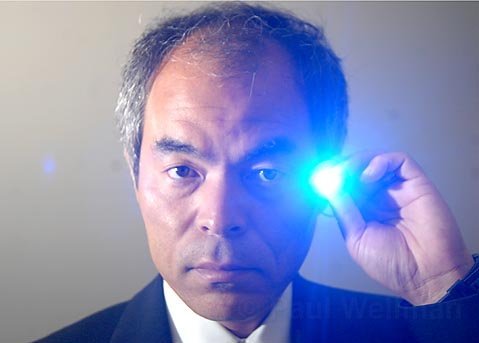
Shuji Nakamura invented the blue LED, without which we wouldn’t be able to have white LEDs, and we would be damaging the environment even more than we are at the moment.
To make white light, you need to have red, green, and blue light in equal quantities. We perceive single wavelengths of light in the visible spectrum as single colors, but when we have all of the wavelengths, that is white. Before Shuji Nakamura invented the blue Led, it was only possible to have red or green lights and all the combinations of those colors. Once he invented the blue LED, it made white light possible and all of the regular lights we use could be replaced with LEDs. LED lights are so much better for the environment than incandescent lightbulbs because they use 75% less energy, they last 25 times longer, and the majority of the energy put into them is released as light, while in incandescent lightbulbs the majority of the energy is released as heat. Without blue LEDs, we couldn’t have smartphones, we couldn’t have
What is an LED? LED stands for Light Emitting Diode. A diode is a semiconductor that is a one-way switch for current. Because of its poor conductibility, current can flow one way, but not the other way, which is why it is called a “semi” conductor. Most materials don’t have this property, so impurities are added to materials to make it more resistant. When these impurities are added, it is called “doping”. To make an LED, two materials are sandwiched together. One is called N-type material and it has extra electrons, which are negatively charged. The other layer is called P-type and it has missing electrons, which make holes that electrons can jump into. There is a gap between the two layers called the depletion zone. When the N-type layer and the P-type layer are placed the right way round and enough current is added, the electrons from the N-type layer will jump across the depletion gap and enter the holes on the P-type layer. When the electrons cross the depletion zone, they release energy and they release it in the form of a photon, which is light. The color of the light depends on the material being used because the electrons will have and release different amounts of energy.
The idea behind the LED was theorized by Oleg Lesev, who was a Russian inventor. The first LED was created by Kurt Lechovec, an American scientist and university teacher. His work led to improvements in the diodes and in 1958, Rustin Braunstein and Egon Loebner managed to make a green LED and then in 1962, Nick Holonyak made a red LED. These were incredible discoveries, but without a blue LED, there wasn’t much use for them other than things like on / off indicators on machines. The logical next step was to make a blue LED, but nobody could work out how to do it. It seemed to be impossible to do and most people gave up.
There were several reasons why a blue LED was difficult to make. All colors are different wavelengths of light within the visible spectrum and red and green have wavelengths with less energy than blue does. To make a blue LED, it would require an N-type material that had electrons with a lot of energy. These electrons would have to jump across the gap into a P-type material that was doped with holes big enough to take the electrons in one jump. If they made two jumps, they would release their energy twice, making red light not blue. Another problem was the structure of the two materials. They had to be pure enough that their atomic structures aligned. Any impurities and the electrons would bounce all over the place. There were several other difficulties as well.
A Japanese engineer called Shuji Nakamura was working for a company called Nichia in Japan. He had been following research by a group led by a Japanese professor called Isamu Akasaki and his student Hiroshi Amano. They had worked out a way to make the p-type material that would hold the electrons with a high enough energy. They had worked out how to dope it, but they didn’t know how to make enough of it and they didn’t know how to make its structure perfect. Nakamura went to the boss of his company and told him that he thought he could make a blue LED. He asked his boss for financial support and his boss gave Nakamura his backing. Nakamura spent years and a lot of money trying to perfect the materials. In 1989, his boss quit and was replaced by his son-in-law who didn’t share his boss’s confidence. He told Nakamura to stop working on the blue LED and to return to other work. Nakamura ignored him then and ignored him repeatedly over the next four years. He worked out how to solve the energy problem, he worked out how to make the crystal structure perfect and he worked out how to make the gap the right size so that the electrons would lose all of their energy at once. And then, probably most importantly, he worked out how to make these things mass-producible. He worked every day for 365 days a year, but, 1993, he had made a blue LED that was strong and could be easily produced. His company, Nichia, started to produce it and their profits went through the roof.
Nakamura won the Nobel Prize for physics in 2014. Thanks to Shuji Nakamura, we can now have white LED lights, in fact, we can have any color LED lights. And those are really starting to help with our carbon footprint and energy consumption. His perseverance and stubbornness and confidence are amazing to behold. And this is what I learned today.
Image By Ladislav Markuš – Own work, CC BY-SA 4.0, https://commons.wikimedia.org/w/index.php?curid=40159287
Sources
https://www.energy.gov/energysaver/led-lighting
https://science.nasa.gov/ems/09_visiblelight/
https://electronics.howstuffworks.com/led.htm
https://www.fluke.com/en/learn/blog/electrical/what-is-a-diode
https://www.energysavinglighting.org/the-history-of-led-lighting/
https://www.ledlightingsupply.com/blog/the-history-of-led-lights
https://www.nobelprize.org/uploads/2018/06/popular-physicsprize2014-1.pdf
https://www.bbc.com/news/science-environment-29518521
https://en.wikipedia.org/wiki/Shuji_Nakamura
https://www.invent.org/blog/inventors/shuji-nakamura-blue-led-lights
